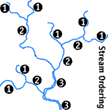 The image Wheeling Creek stream map shows all of the permanently
flowing streams in the Wheeling Creek watershed. Trace the path of a drop of water as it
flows down a gradient from headwaters to mouth. How many stream orders must the water pass
through to reach the Ohio River? View the image watersheds
to see a comparison of the drainage area of third- and fourth-order streams in the
Wheeling Creek watershed. Photo: Courtesy of Dr. Trevor Harris, WVU and Dr. Ben Stout The image Wheeling Creek stream map shows all of the permanently
flowing streams in the Wheeling Creek watershed. Trace the path of a drop of water as it
flows down a gradient from headwaters to mouth. How many stream orders must the water pass
through to reach the Ohio River? View the image watersheds
to see a comparison of the drainage area of third- and fourth-order streams in the
Wheeling Creek watershed. Photo: Courtesy of Dr. Trevor Harris, WVU and Dr. Ben Stout |
 You can determine stream order from a map of a stream
network. A sample stream ordering diagram to the right is provided to assist you. Start by
identifying the smallest streams, those that have no permanently flowing tributaries.
First-order streams are perennial streams, which carry water all year. When two
first-order streams come together, they become a second-order stream. When two
second-order streams come together, they form a third-order stream. However, if a
first-order stream joins a second-order stream, it remains a second-order stream. It is
not until a second-order stream combines with another second-order stream that it becomes
a third-order stream. Print the Wheeling Creek stream map
and see if you can determine the stream order of Wheeling Creek where it enters the
eighth-order Ohio River. Photo:
Courtesy of Hope Sacco Childers You can determine stream order from a map of a stream
network. A sample stream ordering diagram to the right is provided to assist you. Start by
identifying the smallest streams, those that have no permanently flowing tributaries.
First-order streams are perennial streams, which carry water all year. When two
first-order streams come together, they become a second-order stream. When two
second-order streams come together, they form a third-order stream. However, if a
first-order stream joins a second-order stream, it remains a second-order stream. It is
not until a second-order stream combines with another second-order stream that it becomes
a third-order stream. Print the Wheeling Creek stream map
and see if you can determine the stream order of Wheeling Creek where it enters the
eighth-order Ohio River. Photo:
Courtesy of Hope Sacco Childers |
 A first-order stream in a
forested area of the Wheeling Creek watershed. Notice the narrow stream width and the
closed forest canopy. This stream is well-shaded during the months when leaves are on the
trees. Photo: Courtesy of
Kenneth E. Rastall A first-order stream in a
forested area of the Wheeling Creek watershed. Notice the narrow stream width and the
closed forest canopy. This stream is well-shaded during the months when leaves are on the
trees. Photo: Courtesy of
Kenneth E. Rastall |
 A second-order stream in
the headwaters of Wheeling Creek. Photo: Courtesy of Kenneth E. Rastall A second-order stream in
the headwaters of Wheeling Creek. Photo: Courtesy of Kenneth E. Rastall |
 A second-order stream
joins a fourth-order stream. Does the fourth-order stream double in size with the addition
of a second-order stream? Photo:
Courtesy of Pamela S. Rastall A second-order stream
joins a fourth-order stream. Does the fourth-order stream double in size with the addition
of a second-order stream? Photo:
Courtesy of Pamela S. Rastall |
 A third-order stream. How
does the stream's width and forest canopy compare with those of the first-order stream and
the sixth-order stream? Photo:
Courtesy of Kenneth E. Rastall A third-order stream. How
does the stream's width and forest canopy compare with those of the first-order stream and
the sixth-order stream? Photo:
Courtesy of Kenneth E. Rastall |
 Aerial view of a
third-order stream entering a fourth-order stream. Does stream order change when this
tributary enters the larger stream? Photo: Courtesy of Dr. Ben Stout Aerial view of a
third-order stream entering a fourth-order stream. Does stream order change when this
tributary enters the larger stream? Photo: Courtesy of Dr. Ben Stout |
 Wheeling Creek nearing the
Ohio River. How does this stream differ from those above? Photo: Courtesy of Dr. Ben Stout Wheeling Creek nearing the
Ohio River. How does this stream differ from those above? Photo: Courtesy of Dr. Ben Stout |

